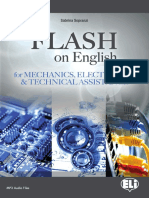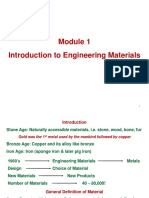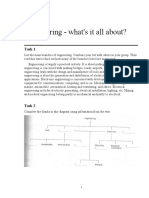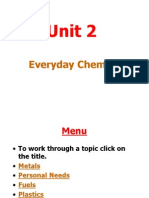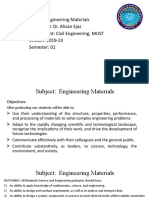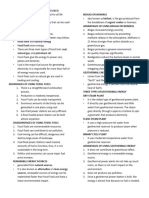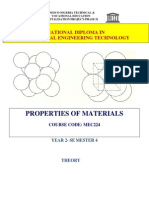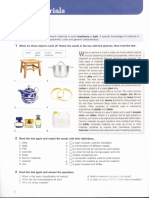0 ratings0% found this document useful (0 votes) 152 views4 pagesMeasurable Parameters
Copyright
© © All Rights Reserved
We take content rights seriously. If you suspect this is your content,
claim it here.
Available Formats
Download as PDF or read online on Scribd
my Measurable parameters
(ZY Supply, demand and capacity
‘The article below is from the technology section of a business magazine
Calculating the capacity ofan electricity grid ~ the amount of energy it needs to supply to users
~ might seem simple, Just add up the power supplied over a given period of time to give the total
amount consumed by users. Then, divide the cumulative amount of power used during the whole
Period by the number of hous inthe period. The results an average level of consumption pe: hou
But theres one problem with this method - and its a major one
B|
‘The rate of power consumption ~ the amount that’s being consumed at @ particular moment - is
ot constant In other words, consumption does not stay at the same level ll the time. So electricity
supply requitements cannot simply be averaged out over time, People use more power at certain
ies of day, and less at other times, which means that demand for power fluctuates significantly
Generally it rises to a maximum in the evening (peak demand is at evening mealtimes), and fas to
ts lowest levels during the night. These fluctuations are so big that at peak times consumption
‘an be twice as high as itis during off-peak times. Cleary the grid needs to have sufficient capacity
to1meet demand when consumption peaks. But since each peak i brie, the grid wil only run to
capacity ~ ator close to its maximum capability ~ fora few moments each day. This means, most of
the time, it has significant spare capacity
HEED put, output and efficiency
Powe nes and vader atl neficent wang ery — may by ging of
| ‘sare er afer etveen Input =the sno of ney pt oe oy pone
gators and eutut— the acura by corner. Ora palo, te fecee beeen
| iota s bot 7 thera Pere lns Bt ey gered te pce
sere consumed and not tested theugh long dsterce power nes so an be
ode Consent, aly pode ett mor etdent on tsps poner a
bereisa gain efiiency of wourd
‘One way to produce power localy i with photovoltaics
(PVs) ~ often called solar panels. However, many PV
installations are stil connected to the electricity grid.
This means that when there is surplus power ~ when
electricity is being produced by the solar panels faster
than its needed in the home — its fed into the gid.
IF consumption exceeds production - if electicity is
being used in the home faster than the solar panels can
produce it~ then power i taken fram the grid. Homes
with low consumption may therefore become net
producers of power, producing more electricity than
they consume.
26 Professional English in Use Engineering�10.1
10.2
10.3
[An enginecr is talking to a colleague about the design of a fuel tank for a water pump.
‘Complete the explanation using the words in the box. Look at A opposite to help you.
average constant consumption duration
capacity consume cumulative _rate
fuel (0) for ris engre ts about 19 les per how. OF cawse, sometines:
11 8 bet mere, sometines a bit leas, depending on the. wortioad. ut
LB 16 a ve Fe. ANE t's £84 ARE (erence OF & werk SEE
|e 8 hows, The pump wl have to be stopped accasionaliy to clean ‘he intake Alter,
20 Ht won't be B hows of (3 vnnne fOntING, Bt WE’ aay B hows, to be on
‘the safe ede. So B hows of corning at a (& vem OF VD Wires per how gues
DCS OF OP ennmrnmmnen COnaUmpHEN over a shift. So WF we want the pnp to have:
coffcient fuel avtonemy for an Behow shift, the (8) enna OF the: fel tank
reeds to be It res, mmm,
‘The graph below shows water consumption in a washing process at a manufacturing plant.
Write figures to complete the comments. Look at A opposite to help you.
1 Water consumption fluctuated between enue ANG suman litres per second.
2 Averaged out over the period shown, consumption was roughly... litres per second.
3 Consumption peaked at a rate of .~ litres per second.
4 If the process ran to capacity, it could use water at a rate Of .u.muuu litres per second.
5 When consumption peaked, the process had spare capacity Of mmm» litres per second.
ee ° paaatasi ae sven Maximum supply capability
aa
ge S
803
Bz?
2 4
Cumulative time ~ seconds
r
Choose the eorrect words from the brackets to complete the explanations from a guided tour
of a manufacturing plant. Look at A and B opposite to help you.
1A lot of heat is generated in this part of the process. And all of that (input / output) is
recycled it provides a (demand / supply} of heat for the next stage of the process. So it’
quite an (efficient / ineficient) system.
2 Sometimes, there's (insufficient / surplus) heat, and it can’t all be recycled. At other times
there isr’t quite enough recycled heat to keep up with (peak / off-peak) demand for heat
energy further along the process.
3 Some material is lost in the washing process, but the mass of water absorbed is greater
than the mass of material lost. So there's a net (loss / gain) in total mass.
oN Tan ceo} .
Think of an energy-consuming appliance you're familiar with. Imagine you are starting @
ens
to redesign it, in order to improve its efficiency. Answer the foll
ek ee eee
i
Cr ena era
ribe any fluctuations, in terms of average and peak consumption
Mee Ls
aR aT
hat are the main reasons for inefficiencies? What are
See
27�a Material types
Metals and non-metals
Engineering materials can be divided into:
© inetals — examples of metallic materials are iron (Fe) and copper (Cu)
© non-metals ~ examples of non-metallic materials are carbon (C) and silicon (Si).
As iron is such a widely used material, metals can be divided into:
(@ fecrous metals - those that contain iron
@ non-ferrous metals ~ those that do not contain iron.
HERD Elements, compounds and mixtures
With regard to the chemical composition of materials - the chemicals they contain, and how
those chemicals are combined ~ three main categories can be used:
@ Elements are pure materials in their most basic form. They cannot be broken down into
different constituents (‘ingredients’). Examples of elements widely used in engineering
materials are iron, carbon and aluminium (Al).
© Compounds consist of two or more elements that are chemically bound ~ that is,
combined by a chemical reaction. An everyday example is water, which is a compound of
hydrogen (H) and oxygen (0).
© Mixtures consist of two or more elements or compounds which are mixed together, but
waich are not chemically bound. In engineering, common examples are alloys ~ that is,
metals which have other metals and/or non-metals mixed with them. A common example
is steel, which is an iron-carbon alloy, and can include other alloying metals ~ metals
which are added to alloys, in small quantities relative to the main metal. Examples of
widely used alloying metals are chromium (Cr), manganese (Mn) and tungsten (W).
BrE: aluminium /,eel.ju'min.i.om/; AmE: aluminum /a'lu:.mi.nam/
Note:
MD composite materials
The article below is from an engineering journal.
era list of chemical elements and their symbols, see Appendix IV on page 104.
No ees os
‘composite materials come to mind ~ such as
ccarbon-fibre, used in aerospace and Formula 4 cars.
But although we think of composites as hitech and
highly expensive, that’s not always true. The earliest
‘examples of composite materials were bricks made
from mud and straw. Or, to use the correct composite
terms, from straw reinforcement - the structural
network that reinforces the material inside, and a mud
‘matrix — the material surrounding the reinforcement.
‘These terms explain what a composite material is: a
matrix with a reinforcing material inside it. A modem,
‘everyday example is fibreglass ~ correctly called glass-
‘reinforced plastic (GRP) — which has a plastic matrix
reinforced with glass fibres.
28 Professional English In Use Engineering�11.1 Complete the sentences using the words in the box. Look at A opposite and Appendix IV on.
page 104 to help you.
metal non-metal metallic non-metallic ferrous non-ferrous
1 Carbon (C) is a.
2 Copper (Ci) is a nn metal,
3 Aluminium (Al) is a commOM on :
4 Steel (Fe + C) is a widely used. metal,
5 Although it is used in steel, carbon is "
6 Aluminium is relatively lightweight for a —nne material,
11.2. Decide whether the sentences below are true or false, and correct the false sentences. Look at
B opposite to help you.
1 The elements that make up a compound are chemically bound.
2 Alloys are chemical compounds that are frequently used in engineering.
3 Alloys can contain both metallic and non-metallic constituents.
4 In an alloy, an alloying metal is the biggest constituent, by percentage.
5 Steel is a metallic element.
11.3 Complete the extract about concrete and steel, using suitable forms of the word reinforce
from C opposite. Sometimes there is more than one possible answer.
(1) onerete is one of the most widely used construction materials, and one we
take for granted. However, using steel bars to (2) . ‘concrete structures located
‘outdoors is only possible thanks to a fortunate coincidence: concrete and steel have practically the
‘same coeficient of thermal expansion — in other words, as atmospheric temperature varies, the
‘concrete and the steel (3) expand and contract at the same rate, allowing uniform |
movement. Using a (4)... materfal with a different coefficient of expansion would not
be feasible. For example, (5) aluminium... concrete would quickly disintegrate.
ee
11.4 Read the text below and find two elements, two compounds, an alloy and a composite.
Look at A,B and C opposite to help you.
Generally, the steel used in reinforced concrete will have previously been exposed to water
and to the oxygen in the air. As a result, it will usually be partly corroded, being covered
with a layer of iron oxide (rust). However, once the steel is inside the hardened concrete,
it will be protected from air and water, which prevents further rusting. Additionally, the
‘cement in concrete does not react aggressively with the iron in steel.
Eres Ca aos
esac) “u
hink of some of the materials used to make products or structures you know about. Say
nether the materials are elements, compounds, mixtures, alloys or composites. If they are
posites, what materials are used (a) as the matrix, and (b) as reinforcement:
Professional English in Use Engineering 29




